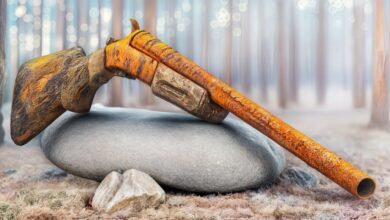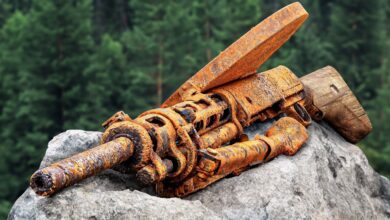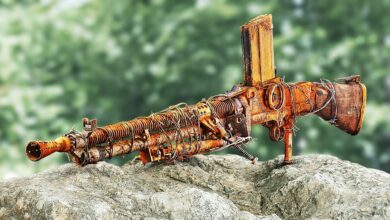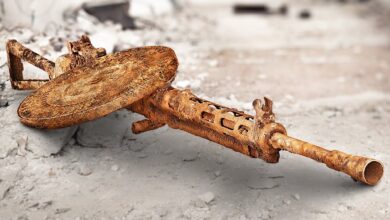Restoring the Old SHKAS Machine Gun: A Glimpse Into Military History and Preservation
The SHKAS (ШКАС) machine gun, a light, air-cooled, belt-fed weapon used extensively by the Soviet Union during World War II, is a symbol of Soviet military ingenuity and technological prowess. Despite being a remarkable piece of engineering during its time, the SHKAS machine gun, like many vintage military weapons, requires restoration to preserve its functionality, historical value, and legacy.
This article delves into the restoration process of the SHKAS machine gun, highlighting its historical significance, technical intricacies, challenges faced during restoration, and the importance of preserving such iconic pieces of history.
A Brief History of the SHKAS Machine Gun
The SHKAS machine gun, designed by the Soviet engineer Shpitalny and first introduced in the late 1930s, was primarily used in aircraft, particularly fighters, during World War II. The gun was chambered for the 7.62x54mmR cartridge and had a high rate of fire — around 1,500 to 2,000 rounds per minute, making it one of the fastest-firing aircraft machine guns of its time. The SHKAS was mounted on a variety of Soviet aircraft, including the famous Ilyushin Il-2 and the Yakovlev Yak-1, where its rapid rate of fire contributed to the aircraft’s combat effectiveness.
However, despite its rapid fire rate, the SHKAS machine gun had some design flaws. The weapon was prone to overheating and had a relatively low effective range, which led to its eventual replacement by more advanced models like the PV-1 and later, the NS-23. Nonetheless, the SHKAS remains a significant part of World War II aviation history.
The Restoration Process
Restoring a vintage SHKAS machine gun is an intricate and specialized process that requires expert knowledge, skills, and access to authentic parts. Here’s an overview of the main stages in restoring this iconic weapon.
1. Acquiring the Original Parts
One of the most challenging aspects of restoring the SHKAS is finding original, authentic parts. Since the SHKAS machine gun was mass-produced in the Soviet Union during the late 1930s and early 1940s, many of these weapons have been either decommissioned, damaged, or lost over time. Restorers often rely on surplus military auctions, museums, and collectors to source original parts or sometimes, they may have to fabricate certain components based on blueprints.
The most common parts that need replacement or restoration are the barrel, bolt mechanism, receiver, and the recoil system. Given that many of these components may have been subjected to years of wear and tear or neglect, locating replacements that meet the original specifications is essential to maintain historical accuracy.
2. Cleaning and Disassembly
Before restoration work can begin, the SHKAS machine gun is thoroughly cleaned and disassembled. Decades of corrosion, dirt, grease, and carbon buildup must be removed. The cleaning process often involves soaking the parts in cleaning solvents, followed by careful scraping and polishing to remove rust without damaging the metal or the original markings.
During disassembly, it’s important to preserve the serial numbers and other markings on the gun to maintain its historical integrity. The SHKAS machine gun’s parts were often hand-stamped with production details, which can help historians and restorers date the weapon and understand its place within the larger context of Soviet military production.
3. Metalwork and Restoration
After the cleaning process, the metal components of the SHKAS are inspected for damage, corrosion, or cracks. Any parts showing signs of structural weakness may need to be welded or replaced. A significant challenge here is ensuring that the parts are restored without compromising the original design and function of the weapon.
For example, the barrel must be carefully examined for wear and tear, as an old barrel may have lost its rifling or developed structural faults. Replacing the barrel can be one of the most complex parts of the restoration, as it needs to maintain the proper dimensions and compatibility with the other components of the machine gun.
4. Reassembly and Function Testing
Once all the parts are cleaned, repaired, and replaced, the machine gun is reassembled. This process involves carefully fitting the components together, ensuring that the timing mechanisms, recoil system, and bolt function as they did when the gun was originally manufactured.
Function testing is a crucial part of restoration. Though modern restorers may not be able to fire live ammunition due to legal restrictions, they simulate firing conditions by using inert or replica ammunition and testing the cycling and overall operation of the gun. Proper headspace, bolt lock, and feed mechanisms are checked to ensure the SHKAS functions as intended.
5. Final Touches and Preservation
After confirming that the machine gun operates properly, the final touches are applied. This may involve reapplying original markings or finishes, such as the blued steel finish that was typical of Soviet-era weapons. The goal is to restore the SHKAS machine gun not only to a functional state but to a visually accurate representation of its original form.
Finally, a protective coating is often applied to prevent future rust or degradation. This preservation process ensures that the SHKAS machine gun can be safely displayed or stored in a museum or private collection for years to come.
Challenges in Restoring the SHKAS Machine Gun
The restoration of a vintage machine gun like the SHKAS is fraught with challenges. Some of the key difficulties include:
- Sourcing Original Parts: As mentioned earlier, original parts for the SHKAS are rare and often require creative solutions for restoration.
- Preserving Historical Integrity: Restorers must be careful not to compromise the authenticity of the weapon. Using modern materials or techniques that weren’t available at the time of production could detract from its historical value.
- Legal Constraints: In many countries, there are strict laws governing the possession, restoration, and use of firearms, especially military-grade ones. Restorers must adhere to these regulations, which can limit certain restoration methods or the ability to test the weapon fully.
Why Restoring the SHKAS Matters
Restoring the SHKAS machine gun is not just about reviving an old weapon; it’s about preserving a piece of military history. Weapons like the SHKAS provide invaluable insight into the technological advances of the time and the role of aviation in World War II. Restoring these weapons allows modern generations to understand the evolution of warfare and the sacrifices made by those who used these tools in battle.
Moreover, historical weapons like the SHKAS are often housed in museums, where they serve as educational tools for future generations. Their restoration helps maintain the integrity of these institutions and preserves the legacy of those who fought in significant conflicts like World War II.
Conclusion
Restoring the SHKAS machine gun is both a technical challenge and a labor of love for collectors, historians, and military enthusiasts. This process ensures that a vital piece of history is preserved for future generations. While it may require considerable expertise, resources, and patience, the end result is a fully restored piece of Soviet engineering that reflects the ingenuity and determination of the past. Through careful restoration, the SHKAS remains an enduring symbol of wartime innovation and a testament to the history of military technology.






